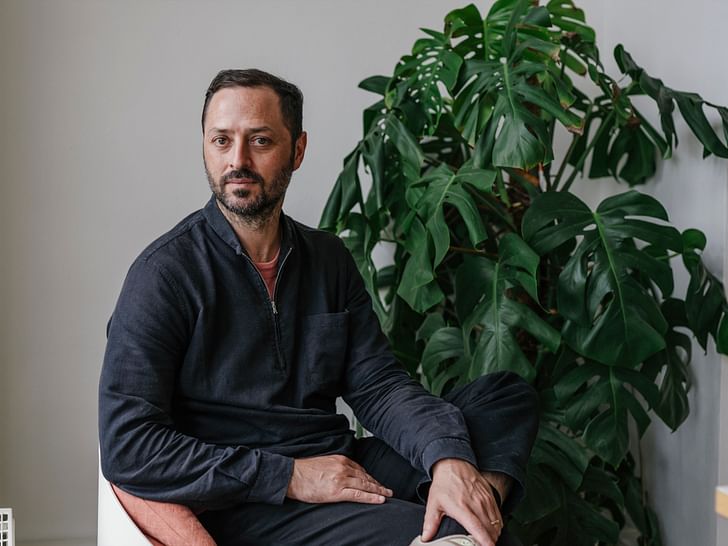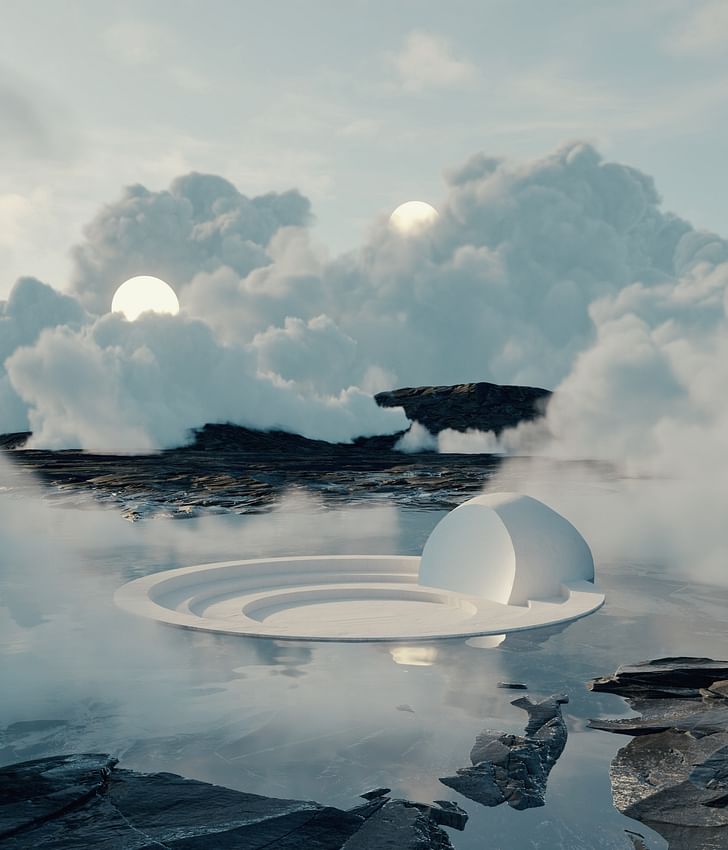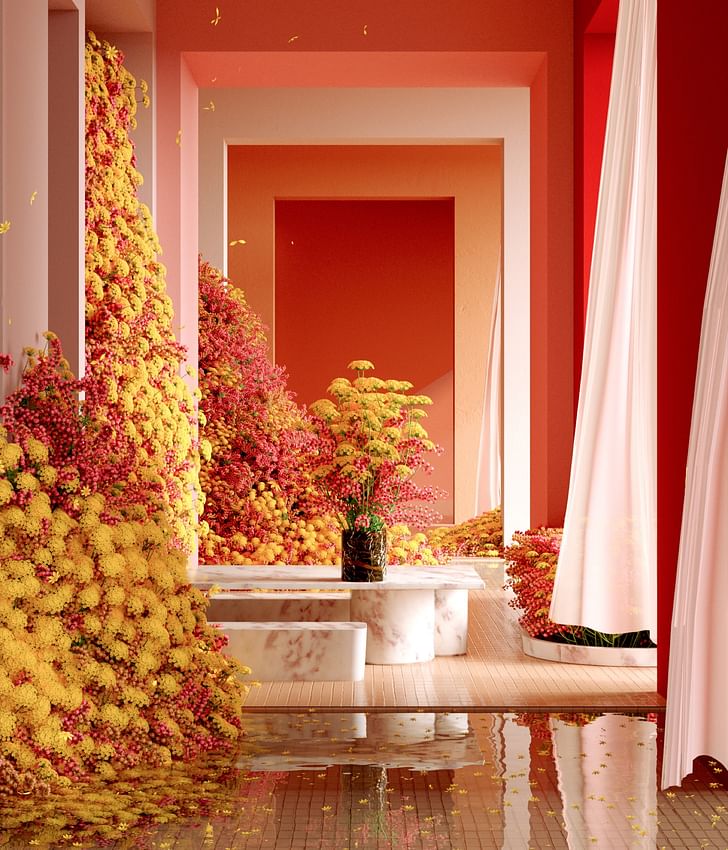

Studying Alexis Christodoulou’s work, including his highly popular Instagram portfolio, one would expect his images to be the product of decades of education, training, and practice at the top of the field. The fact that Christodoulou is a self-taught artist of ten years, preceded by a career in advertising and winemaking, is a testament to the artist’s flair and passion for exploring new frontiers.
That same passion for exploration has allowed Christodoulou’s work to evolve from its simple architectural beginnings to vivid, minimalist experiments in Modernism, Brutalism, and the natural world, to present-day commissions by luxury brands through his company, Color C Design Studio.
In June 2023, Archinect’s Niall Patrick Walsh spoke with Christodoulou about his career in 3D visualization, including his background, process, tools, and thoughts on how artificial intelligence intersects with his field. The discussion, edited slightly for clarity, is published below.
This article is part of the Archinect In-Depth: Artificial Intelligence series.
Niall Patrick Walsh: Could we begin with an introduction to you and your work?
Alexis Christodoulou: I am a 3D artist currently living in Amsterdam, where I moved from Cape Town three years ago. I am the creative director of my 3D firm, Color C Design Studio. I started my journey as a self-taught artist a decade ago when I started teaching myself how to use 3D modeling software in the mornings and evenings around my main job, which at the time was advertising and winemaking. I went from a 3D hobbyist to a freelance 3D artist to the director of a 3D studio.
Today, our commercial work is mainly with luxury brands such as cosmetics, perfumes, and wellness brands. In my personal capacity, I’ve always been interested in exploring the artistic and the architectural. Of course, the personal and commercial have a way of bleeding together. I work with a team of five people now on both the artistic and commercial commission sides.

How did you go from an advertising copywriter and winemaker to a 3D artist? What was it that attracted you to visual arts? It is usually most people’s dream to go from professional to winemaker, not the other way around!
At least I know how to make wine now; I’ll have a good head start if I ever go back to it! I feel like I have always had a repressed artistic inclination. I actually have an identical twin brother, and as is often the case, our parents tried to impress our own separate identities early on in life. My brother went down the artistic route in high school while I did accounting, so in our minds, he was the artist in the family. I left art behind and studied writing, which, although creative, didn’t have an artistic background. I became interested in literature which led me to become a copywriter in advertising.
It made me feel like I was playing a video game again where I kept advancing in level exponentially. — Alexis Christodoulou
However, this all happened against the backdrop of interesting technological leaps. My generation grew up playing video games at a time when games were making massive visual leaps every year. The changes in graphics year-on-year were incredible; we were experiencing the full effect of Moore's Law. My interest in video games was, therefore, as much about the technology behind the game itself: the renderings, visual identity, etc. I assumed that one had to go to school to learn 3D animation, lighting, and mesh creation, because of how inaccessible it all looked. Then one day, I saw a musician friend of mine using SketchUp to create a coffee table, all from a YouTube tutorial. From there, the floodgates opened for me. I downloaded SketchUp and used YouTube to get as much direction as possible. I moved from SketchUp to Cinema 4D to other rendering engines; it was a progression of obsession. It made me feel like I was playing a video game again where I kept advancing in level exponentially.

It was almost like your own Moore’s Law.
Exactly. I totally embraced 3D and allowed myself to get lost in it; a process which I see many of my studio colleagues doing too. All of the people in my studio are self-taught, and they all have the same reaction to 3D. They jumped in, started playing around, and got completely obsessed and immersed.
I was lucky starting out that I had a day job that supported me while I learned 3D modeling, so I did not give up and become too commercial too quickly. I was able to play. I started to explore styles that I didn’t see represented much in the 3D space, including Modernism, mid-century architecture, eighties deco, and more retro, futuristic architecture, and Brutalism. That’s still a mission of the studio today, finding new aesthetics that haven’t been explored in the discipline.

You mentioned that your colleagues at Color C Design Studio are also self-taught. What backgrounds did they come from? It must make for a fascinating range of experiences to draw on.
We have a guitarist, an industrial designer, a filmmaker, and someone from a communications background, so it is quite varied. We once had an intern who studied economics, who was great. One advantage of 3D art is that you don’t need a traditional artistic background. Obviously, that would help, but there are many ways to express yourself in 3D. That is even more true today with AI. People can take ideas from their head, translate it onto a computer screen, and put it out into the world without spending years in formal art studies. This perhaps explains, in part, why our studio attracts people from so many different areas.

I’m curious about how you choose styles and subjects. Looking at your work, there are many strands. Architecture is definitely one, as you mentioned. There is also a heavy presence of nature and geology, whether it is sand dunes, mountains, or water. I also noticed that you don’t seem to include people in your images. Then there is this vivid, minimalist aesthetic underlying everything. I am curious about whether you see it this way, how intentional each of these things is to you, and what they mean to you.
Yes, each of those points is correct. It actually goes back to this idea of progression I talked about earlier. In the beginning, I was making architecture because I didn’t know how to create natural elements like plants. As time went on, my software and hardware capabilities improved, allowing me to add more elements. As I got better, nature started to play a role, which allowed me to create external landscapes. Then when I adopted Unreal Engine, it became possible to make beach waves, and so on.
That’s still a mission of the studio today, finding new aesthetics that haven’t been explored in the discipline. — Alexis Christodoulou
The exclusion of humans was also conscious. I always seek to create a space that the viewer could include themselves in without me adding the gaze or trying to direct the viewer in how they should think about the space. It is also a major challenge to add characters without making them either look illustrative or create an ‘uncanny valley’ effect. Instead, I tried to create spaces that were interesting even without adding characters, which is a nice challenge. How do you make a space compelling without characters? Architectural photographers have been doing it for a long time, so I learned a lot from studying what had already been done with perspectives, depth, etc.

This approach of ‘learning by doing’ is highly instructive. Looking at your work, one would assume that you had extensive formal training followed by decades of practice in the field and that your entire portfolio is the culmination of this. Instead, you asked, ‘What skills and software do I have access to right now?’ and ‘What is the best possible work I can make from it?’ There is a tendency among many, particularly creatives, to engage in a sort of ‘analysis paralysis’ where we only start producing and publicizing work when we feel like we have reached a certain level, or learned certain skills. Your work is instead a powerful testament to the results of learning by doing.
This also brings us to the topic of what software you use today in your work. Can you give us an insight?
So, our production software is Cinema 4D, with Redshift as our renderer. Unreal Engine is a sort of play area for us to test ideas internally, but if a client came into the office for a commercial project, we would use Cinema 4D and Redshift to deliver that. While we are excited about some of the things Unreal Engine is capable of, they are still trying to appeal to a broad audience beyond 3D artists, which is a bit frustrating. Elsewhere, DaVinci Resolve is where we do all of our color grading and editing. For stills, we also use Lightroom and Photoshop. Now, of course, Photoshop has an embedded AI tool, which we are experimenting with. We often use Midjourney for generating research images, which we then take into Photoshop or even into Stable Diffusion to modify them further. And then, like every designer, we use Pinterest a lot!

Don’t we all! You mentioned using Midjourney for research. Could we unpack that more?
Yes, so our images, in general, require a lot of research. We use AI to build our research boards and for playing with our sketches. We now try to sketch in 3D and complete all steps in a 3D program. In the beginning, I was sketching a lot more on paper and taking physical photographs. Now, it is more of an intuitive process, where I live in the 3D scene as I build it. Often, I will place elements and ideas into the scene and then start to peel them back until my instincts tell me the image is ready.
In the right hands, AI is a great tool for extending our research capabilities. — Alexis Christodoulou
But yes, we use Midjourney to blend images, come up with ideas, and see if there is anything interesting in the results that can enrich our project. We sometimes take reference boards given to us by clients and blend them together in Midjourney to see what happens. In the right hands, AI is a great tool for extending our research capabilities. I doubt I would use Midjourney for an actual production project, given that the resolution isn’t high enough for us. There is also this looming conversation over copyright to be considered before incorporating AI into our finished images.

This question of how generative AI intersects with human 3D artists is something at the forefront of many creative minds now. Do you think you and your colleagues have anything to fear from AI?
There is a much wider AI conversation beyond text-to-image tools which I can’t claim to know much about, so to a certain extent, I just have to let it run its course. But from the perspective of architectural visualization, image creation, and even idea creation, I definitely think that you need to use AI much more than you think to get unique results from it. Otherwise, you end up making the same stuff as everybody else. You can ask AI to do a lot of your image generation for you, but you still have to think about it in a way. Perhaps there is someone in Google or OpenAI working on changing that, but for now, it is a great companion tool that has to be embraced for what it is.
You can ask AI to do a lot of your image generation for you, but you still have to think about it in a way. — Alexis Christodoulou
We are also still struggling with information overload. Today, one of my colleagues said to me: “I don’t know what to do. I have 3,000 images. How do I know which is best?” AI has given us an ‘abundance of choice’ problem. There are still interventions that need to happen on a human level, and those humans need to have the right perspective on what they want. When you start using AI, and you know what you want to get out of it, it is a great tool. But when you don’t know what you want to get from it, you might actually be more confused at the end and have lost 16 hours in the process.

Amidst everything we have talked about today, what is one final message or reflection you want to give readers on 3D imagery?
I want to return to what you said earlier about me not waiting until I reached a certain level before I put my art out into the world. I would recommend this to anybody who is trying to learn this skill. I saw social media as a tool in order to get my work out there and not have the opportunity to change it; I had to move on to the next piece. In the beginning, I made a promise to myself that I would release an image every two days. It didn’t matter if the image was bad or I didn’t like it, I gave myself no choice. I found that people do not hold you liable for bad images. Instead, they hold you in respect for the good images. We all have this fear that people are going back in time to inspect your entire portfolio and not hire you because of one bad image from ten years ago. But if anything, the early images are a demonstration of how far you have come.
I found that people do not hold you liable for bad images. Instead, they hold you in respect for the good images. — Alexis Christodoulou
Whatever platform you choose to post on, make a habit out of it. That habit helps you progress quickly. Again, you don’t need to come out with your best work on day one. Even now, I’m probably going to post something that has errors that I do not know how to fix. But that’s not the point. The point is to keep moving. I know many established artists who started off with a similar commitment to post every day or every two days. If you want to get into 3D imagery, it is a great way to begin.
Niall Patrick Walsh is an architect and journalist, living in Belfast, Ireland. He writes feature articles for Archinect and leads the Archinect In-Depth series. He is also a licensed architect in the UK and Ireland, having previously worked at BDP, one of the largest design + ...
No Comments
Block this user
Are you sure you want to block this user and hide all related comments throughout the site?
Archinect
This is your first comment on Archinect. Your comment will be visible once approved.